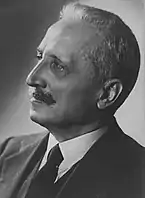Legislature I of Italy
The Legislature I of Italy (Italian: I Legislatura della Repubblica Italiana) was the 1st legislature of the Italian Republic, and lasted from 8 May 1948 until 24 June 1953.[1][2] Its composition was the one resulting from the general election of 18 April 1948.
Legislature I of Italy I legislatura della Repubblica Italiana | |
|---|---|
| 1st legislature | |
| Type | |
| Type | |
| Houses | Chamber of Deputies Senate of the Republic |
| History | |
| Founded | 8 May 1948 |
| Disbanded | 24 June 1953 (5 years, 47 days) |
| Preceded by | Constituent Assembly |
| Succeeded by | II Legislature |
| Leadership | |
List
| |
| Structure | |
| Seats | 574 (C) 343 (S) |
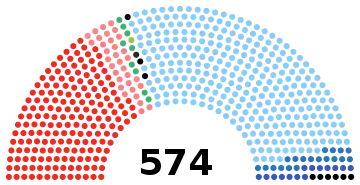 | |
Chamber of Deputies political groups | |
 | |
Senate political groups | |
| Elections | |
| Proportional | |
| Proportional | |
Last general election | 18 April 1948 |
| Meeting place | |
| Palazzo Montecitorio, Rome (C) | |
| Palazzo Madama, Rome (S) | |
| Website | |
| First Legislature – Chamber of Deputies First Legislature – Senate | |
| Constitution | |
| Constitution of Italy | |
Main chronology
In the 1948 general election Christian Democracy (DC) went on to win a decisive victory with the support of the Catholic Church and obtained 48.5% of the vote, defeating the leftist social-communist alliance of the Popular Democratic Front (FDP). Despite his party's absolute majority in the Italian Parliament, Prime Minister Alcide De Gasperi continued to govern at the head of the centrist coalition, which was successively abandoned by the Italian Liberal Party (PLI) in 1950 and by the Socialist Party of Italian Workers (PSLI) in 1951.
Under De Gasperi, the first republican Parliament carried out major land reforms to help the poorer rural regions in the early postwar years, with farms appropriated from the large landowners and parcelled out to the peasants. In addition, the Parliament passed a number of laws safeguarding employees from exploitation, established a national health service, and initiated low-cost housing in Italy’s major cities.[3] Here's a list of the main laws approved by the Parliament:
- Law 28 February 1949, n. 43 – "Measures to increase workers' employment, facilitating the construction of houses for workers". The law, also known as Fanfani house program, was promoted by the Minister of Labour Amintore Fanfani and launched a seven-year plan for popular housing to increase the stock of economic housing by means of construction or purchase of economic accommodation. The law also established a special housing fund, the so-called "INA-Casa", within the National Institute for Insurance.
- Law 10 August 1950, n. 646 – "Establishment of the Fund for extraordinary works of public interest in Southern Italy". The law established the Cassa per il Mezzogiorno (Fund for the South) to encourage the development of public works and infrastructure (roads, bridges, hydroelectric and irrigation) projects, and to provide credit subsidies and tax advantages to promote investments in the poor and mainly agricultural regions of Southern Italy.
- Law 21 October 1950, n. 841 – "Rules for expropriation, reclamation, transformation and assignment of land to peasants", also known as the "Agrarian Reform". The law promoted the redistribution of lands to peasants in the poorer rural regions and the formation of agricultural cooperatives.
- Law 24 February 1951, n. 84 – "Rules for the election of municipal councils". The reform changed the electoral law used for the election of the municipal councils, introducing a block voting system and abolishing the proportional representation.
- Law 31 March 1953, n. 87 – "Amendments to the law for the election of the Chamber of Deputies", also known as Scam Law.
The end of the legislature was characterized by some controversial changes in the electoral law proposed by the government. Even if the general structure remained uncorrupted, the government introduced a superbonus of two thirds of seats in the Chamber of Deputies for the coalition which would obtain at-large the absolute majority of votes. The change was hugely opposed by the opposition parties as well as the smaller DC coalition partners, which had no realistic chances of success. The new law was called Scam Law by its detractors,[4] including some dissidents of minor government parties who founded special opposition groups to deny the artificial landslide to the DC.
Presidential election
On 10 May 1948 the newly elected Parliament met to elect the first President of Italy. On 11 May 1948 liberal economist Luigi Einaudi was elected on the fourth ballot with 518 votes out of 900.
Government
| Prime Minister | Party | Term of office | Government | Composition | |||
|---|---|---|---|---|---|---|---|
| Took office | Left office | ||||||
 |
Alcide De Gasperi (1881–1954) |
Christian Democracy | 23 May 1948 | 27 January 1950 | De Gasperi V | DC • PSLI • PLI • PRI (Centrism) | |
| 27 January 1950 | 26 July 1951 | De Gasperi VI | DC • PSLI • PRI (Centrism) | ||||
| 26 July 1951 | 16 July 1953 | De Gasperi VII | DC • PRI (Centrism) | ||||
De Gasperi V Cabinet
| 16 June–2 July 1948 Investiture votes for De Gasperi V Cabinet | |||
|---|---|---|---|
| House of Parliament | Vote | Parties | Votes |
| Chamber of Deputies (Voting: 513 of 574, Majority: 257) |
DC, PSLI, PLI, PRI | 346 / 513 | |
| FDP, MSI, PNM | 167 / 513 | ||
| Senate of the Republic (Voting: 255 of 343, Majority: 128) |
DC, PSLI, PLI, PRI | 184 / 255 | |
| PCI, PSI, MSI, PNM | 67 / 255 | ||
| Abstention | Others | 4 / 255 | |
De Gasperi VI Cabinet
| 14 February–1 March 1950 Investiture votes for De Gasperi VI Cabinet | |||
|---|---|---|---|
| House of Parliament | Vote | Parties | Votes |
| Chamber of Deputies (Voting: 503 of 574, Majority: 252) |
DC, PSLI, PRI | 314 / 503 | |
| PCI, PSI, PLI, MSI, PNM | 189 / 503 | ||
| Senate of the Republic (Voting: 296 of 343, Majority: 149) |
DC, PSLI, PRI | 176 / 296 | |
| PCI, PSI, PLI, MSI, PNM | 110 / 296 | ||
| Abstention | Others | 10 / 296 | |
De Gasperi VII Cabinet
| 8–9 August 1951 Investiture votes for De Gasperi VII Cabinet | |||
|---|---|---|---|
| House of Parliament | Vote | Parties | Votes |
| Senate of the Republic (Voting: 260 of 343, Majority: 131) |
DC, PRI | 151 / 260 | |
| PCI, PSI, PSLI, PLI, MSI, PNM | 101 / 260 | ||
| Abstention | Others | 8 / 260 | |
| Chamber of Deputies (Voting: 466 of 574, Majority: 234) |
DC, PRI | 291 / 466 | |
| PCI, PSI, PSLI, PLI, MSI, PNM | 175 / 503 | ||
Parliamentary composition
Chamber of Deputies
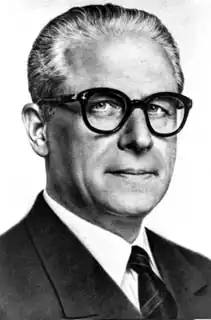
- President: Giovanni Gronchi (DC), elected on 8 May 1948
- Vice Presidents: Giuseppe Fruschini (DC, until 10 July 1949), Gaetano Martino (PLI), Giuseppe Chiostergi (PRI), Ferdinando Targetti (PSI, until 21 January 1953)
| Initial composition[5] (8 May 1948) |
Final composition[5] (24 June 1953) | ||||||||
|---|---|---|---|---|---|---|---|---|---|
| Parliamentary group | Seats | Parliamentary group | Seats | Change | |||||
| Christian Democracy | 305 | Christian Democracy | 300 | ||||||
| Popular Democratic Front | 183 | Italian Communist Party | 126 | ||||||
| Italian Socialist Party | 53 | ||||||||
| Socialist Unity | 33 | Socialist Unity | 33 | ||||||
| National Bloc | 19 | Italian Liberal Party | 13 | ||||||
| Monarchist National Party | 14 | Monarchist National Party | 19 | ||||||
| Italian Republican Party | 9 | Italian Republican Party | 8 | ||||||
| Italian Social Movement | 6 | Italian Social Movement | 6 | ||||||
| Mixed | 5 | Mixed | 16 | ||||||
| Südtiroler Volkspartei | 3 | Südtiroler Volkspartei | 3 | ||||||
| Peasants' Party of Italy | 1 | Peasants' Party of Italy | 1 | ||||||
| Sardinian Action Party | 1 | Sardinian Action Party | 1 | ||||||
| Independents – Non inscrits | 11 | ||||||||
| Total seats | 574 | Total seats | 574 | ||||||
Senate of the Republic
- Presidents:
- Ivanoe Bonomi (PSLI), elected on 8 May 1948 and resigned on 20 April 1951;
- Enrico De Nicola (PLI), elected on 28 April 1951 and resigned on 24 June 1952;
- Giuseppe Paratore (PLI), elected on 26 June 1952 and resigned on 23 March 1953;
- Meuccio Ruini (Ind), elected on 25 March 1953.
- Vice Presidents: Antonio Alberti (DC, until 16 March 1953), Salvatore Aldisio (DC, until 26 January 1950), Mauro Scoccimarro (PCI), Enrico Molé (US), Adone Zoli (DC, from 3 March 1950 to 25 July 1951), Giovanni Battista Bertone (DC, from 10 August 1951), Umberto Tupini (DC, from 17 March 1953)
| Initial composition[6] (8 May 1948) |
Final composition[6] (24 June 1953) | ||||||||
|---|---|---|---|---|---|---|---|---|---|
| Parliamentary group | Seats | Parliamentary group | Seats | Change | |||||
| Christian Democracy | 148 | Christian Democracy | 146 | ||||||
| Italian Communist Party | 77 | Italian Communist Party | 73 | ||||||
| Italian Socialist Party | 41 | Italian Socialist Party | 38 | ||||||
| Socialist Unity | 23 | Socialist Unity | 21 | ||||||
| Italian Republican Party | 11 | Italian Republican Party | 7 | ||||||
| National Bloc | 10 | Italian Liberal Party | 9 | ||||||
| Italian Social Movement | 3 | Italian Social Movement | 3 | ||||||
| Mixed | 30 | Mixed | 20 | ||||||
| Südtiroler Volkspartei | 2 | Südtiroler Volkspartei | 2 | ||||||
| Sardinian Action Party | 1 | Sardinian Action Party | 1 | ||||||
| Independents – Non inscrits | 27 | Independents – Non inscrits | 17 | ||||||
| Total seats | 343 | Total seats | 317[lower-alpha 1] | ||||||
- Senators elected in 1948 were actually 237. The new Senate was initially composed by newly-elected senators and former members of the Constituent Assembly, of which 32 died during the term and weren't replaced. 8 new lifetime senators were appointed during the term by President Luigi Einaudi.
Senators for Life
| Senator | Motivation | Appointed by | From | Till |
|---|---|---|---|---|
| Enrico De Nicola | Former President of Italy | ex officio | 12 May 1948 | Next legislature |
| Guido Castelnuovo | Merits in the scientific field | President Luigi Einaudi | 5 December 1949 | 27 April 1952 (deceased) |
| Arturo Toscanini | Merits in the artistic field | President Luigi Einaudi | 5 December 1949 | 7 December 1949 (resigned) |
| Pietro Canonica | Merits in the artistic field | President Luigi Einaudi | 1 December 1950 | Next legislature |
| Gaetano De Sanctis | Merits in the social and literary field | President Luigi Einaudi | 1 December 1950 | Next legislature |
| Pasquale Jannaccone | Merits in the social field | President Luigi Einaudi | 1 December 1950 | Next legislature |
| Carlo Alberto Salustri, known as "Trilussa" | Merits in the literary field | President Luigi Einaudi | 1 December 1950 | 21 December 1950 (deceased) |
| Luigi Sturzo | Merits in the social field | President Luigi Einaudi | 17 September 1952 | Next legislature |
| Umberto Zanotti Bianco | Merits in the artistic and social field | President Luigi Einaudi | 17 September 1952 | Next legislature |
Gallery
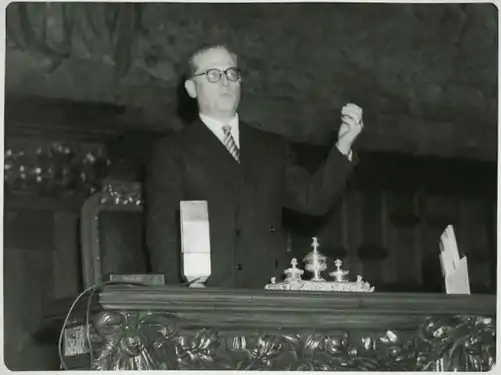 Giovanni Gronchi as President of the Chamber of Deputies in 1948
Giovanni Gronchi as President of the Chamber of Deputies in 1948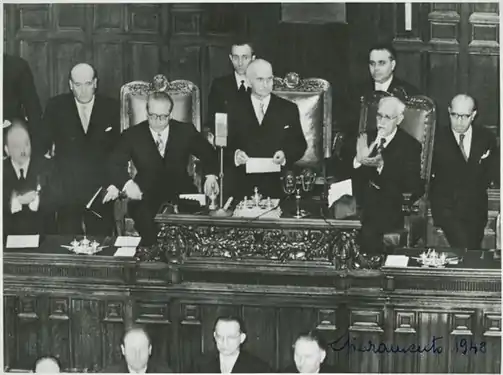 President Luigi Einaudi inaugural address on 12 May 1948
President Luigi Einaudi inaugural address on 12 May 1948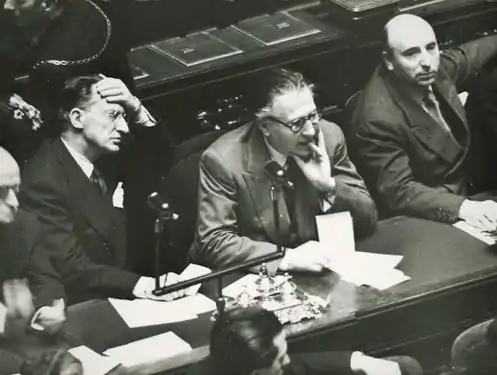
References
- "Camera dei Deputati – 1ª Legislatura". www.storia.camera.it (in Italian). Retrieved 17 January 2021.
- "Senato della Repubblica – 1ª Legislatura". www.senato.it (in Italian). Retrieved 17 January 2021.
- Library of Nations: Italy, Time-Life Books, 1985
- Also its parliamentarian exam had a disruptive effect: "Among the iron pots of political forces that faced in the Cold War, Senate cracked as earthenware pot": Buonomo, Giampiero (2014). "Come il Senato si scoprì vaso di coccio". L'Ago e Il Filo.
- "I Legislatura della Repubblica italiana / Legislature / Camera dei deputati – Portale storico". storia.camera.it (in Italian). Retrieved 17 January 2021.
- "senato.it – Composizione dei gruppi parlamentari nella I Legislatura". www.senato.it (in Italian). Retrieved 17 January 2021.

